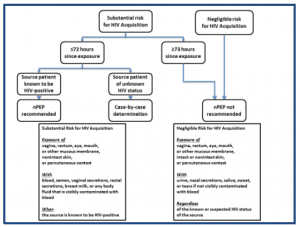Sexual assault
Background
- Male victim in 10% of cases
- Toluidine blue: detects vulvar tears
- Wood's lamp: detects semen stains
Clinical Features
- History of sexual exposure without consent
- May or may not have symptoms/signs of injury
Differential Diagnosis
Evaluation
General
- Check for life threats, emergent medical needs, and injuries first
- If patient consents to forensic exam after medical evaluation
- Ask patient not to change, shower, eat, drink, or wash hands
- Do not give wet wipe and ask patient not to wipe when giving urine sample. Collect dirty catch urine
- Defer GU examination if patient consents to SANE (sexual assault nurse examiner) exam
- Contact SANE (sexual assault nurse examiner) and police (if report not already filed and patient consents, or if required by law)
Labs
- Pregnancy test
- Rapid HIV
- Hepatitis panel
- Hepatitis B surface antigen
- Hepatitis C viral load
- RPR
- Urine GC/chlamydia, if not collected by SANE
- If considering HIV PEP, need baseline labs
- CBC
- Chemistry
- LFTs
Management
- Consider emergency contraception if possibility of pregnancy
Empiric Antibiotics for STDs

HIV nonoccupational exposure algorithm
- Ceftriaxone 250mg IM in a single dose AND
- Azithromycin 1g orally in a single dose AND
- Metronidazole 2g orally in a single dose OR
- Tinidazole 2g orally in a single dose
- HIV post-exposure prophylaxis
- Post-exposure prophylaxis (PEP) recommended as soon as possible if <= 72 hours since exposure AND
- Assailant HIV positive
- Assailant HIV status unknown, but patient's mucous membranes or non-intact skin exposed to blood, semen, vaginal secretions, or bloody body fluids
- Post-exposure prophylaxis (PEP) recommended as soon as possible if <= 72 hours since exposure AND
Vaccines
- Tetanus vaccine
- Hepatitis B post-exposure prophylaxis
- Even if patient is vaccinated, give HBV vaccine booster shot, preferably within 24 hours of exposure[1]
- HPV vaccine for female patients age 9-26 and male patients 9-21 if patient has not already completed series of 3 vaccines[2]
- Remember to attend to patient's emotional needs as well, consider social work consult and/or offering support resources such as [Rape, Abuse & Incest National Network] 800-656-HOPE
Disposition
- Typically outpatient
References
- CDC 2015 Sexually Transmitted Diseases Treatment Guidelines. https://www.cdc.gov/std/tg2015/sexual-assault.htm
- CDC 2015 Sexually Transmitted Diseases Treatment Guidelines. https://www.cdc.gov/std/tg2015/sexual-assault.htm
This article is issued from
Wikem.
The text is licensed under Creative
Commons - Attribution - Sharealike.
Additional terms may apply for the media files.